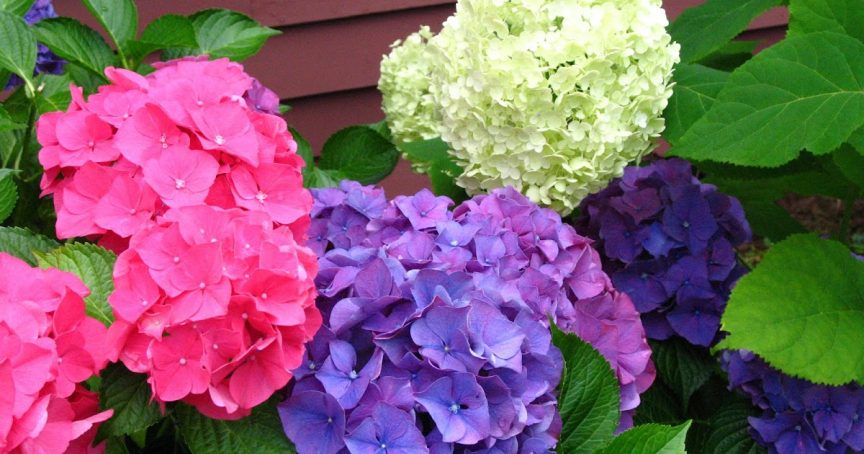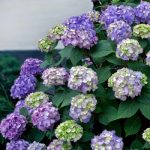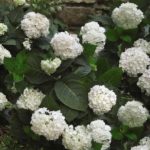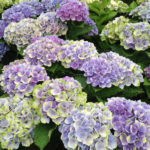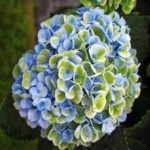Of all the flowering shrubs this has always been a show stopper! They are long living shrubs that bloom most of the summer and well into fall. With so many new varieties and colours to choose from you’re certain to find one that is right for you!
Endless Summer Hydrangeas are unique as they can grow enormous, bold flowers on both old and new wood—making for a potentially long blooming season. By adjusting your soil pH you can customize the blooms of this particular hydrangea to grow either blue, light lavender, soft pink, or deep pink blooms. For a bluer shade, make sure your soil is acidic. For blooms that are more pink, amend the soil to be more alkaline. Products are available are many garden centers to help you out. Although these hydrangeas can grow in a range of soils they all will need moisture to flourish. During dry hot spells a plant will be using all its water reserves to stay alive – and not to produce large bright blooms that you are expecting if it is not being helped with additional watering to aid in it’s survival. Giving your plant a good deep watering once a week will help the nutrients travel through the plant allowing the stems, leaves, and flowers to flourish. Adding some mulch at the base of the plant will also help keep moisture in. As a cold-hardy specimen, Endless Summer Hydrangeas can even tolerate a bit of frost meaning they could bloom well into late fall.
You do not need to prune your Endless Summer Hydrangea, because they can bloom on both old and new growth. But you should trim any dead, dying, or diseased branches when you notice them to keep the plant healthy.
Everlasting Hydrangeas
Showing off a parade of purple colors, the Everlasting Amethyst hydrangea, delivers a look that lives up to its name adding brilliant color to your gardens. The long-lasting blooms emerge in vibrant fuchsia that will transition to violet-blue, transforming your landscape throughout the summer. Changing the acidity of your soil will also help change the colors of your blooms.
Even better is its carefree growth and compact size, with sturdy stocks, growing 2-3 feet high and wide on old wood. This plant blooms on old wood so no need to prune them back. You can still remove dead or damaged wood in the spring.
Despite its brilliant color and huge blooms, the Everlasting Amethyst Hydrangea is well-suited for nearly any space in your garden – from borders along your driveway to flower beds in your front yard.
PRUNING
Why Is My Hydrangea Not Blooming?
- The most common reason for no blooms is over pruning or pruning at the wrong time of the year. If your Hydrangea is not blooming, you may have accidntally pruned away the flower buds. It is best to read the individual labels of each hydrangea shrub to know when or if pruning is needed. Each hydrangea will differ. Some of the newer varieties grow flower heads on new and old growth. In general, it is better to prune away any dead branches in late fall or early spring, and to keep in mind not to over prune to ‘shape’ the shrub, but merely to cut away the oldest stems.
- The hydrangea can bloom on what’s called “new wood” or “old wood.” Old wood refers to the stems that have been on the plant since the summer before. New wood refers to the stems that have just developed on the plants during the current season.
- Another common cause of poor blooms is an early spring cold snap. As many varieties bloom on old wood, a late frost can damage any flower buds that have already emerged.
TIPS AND TRICKS
Changing the Color of a Hydrangea
- It is possible to change the flowers’ colors but this is not an instant change. Color correction can take weeks or longer. (sometimes a season or two!) It is easier to change blue flowers to pink than to change pink flowers to blue. Wait until the plant is established and at least 1-2 years old before trying to change its colour.
- To get blue flowers, you need to lower the pH, which you can do by adding aluminum sulphate, a specifically made product or peat moss to the soil.
- To get pink to light red flowers, you can increase the pH by adding ground limestone around the base of the plant.
- Note: that hard water with all it’s minerals can affect the flower colour, turning blue flowers more pinkish so try and use ‘softer’ rainwater to water your hydrangeas.
*Note: Not all hydrangeas though can be changed to produce blue or purple blooms. Flower color can only be changed on specific species of hydrangeas, so be sure to do your research before purchasing any hydrangea if you are planning on trying to change the color of the flowers to be blue or purple.
The amount of aluminum that a plant can access through the soil will help with determining the color when planning to change the hue of your hydrangea. A lower ph level in the soil allows the aluminum to be more soluble which then in turn allows the plant to more readily absorb it.

